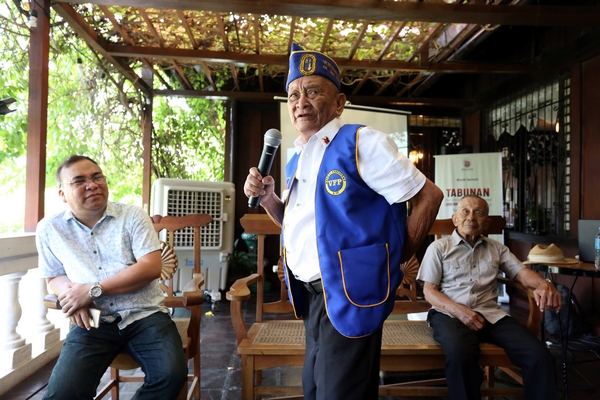
SURVIVING THE WAR. Luis Jabonero, 89, (center) and Marcelo Barega, 84 (right), both World War II veterans, talk about their experiences during WW II. With them is Dr. Jobers Reynes Bersales, University of San Carlos (USC) Press manager, the speaker of the forum Surviving the War held at the Casa Gorordo Museum on April 18, 2018. CDN PHOTO/ JUNJIE MENDOZA
Only a few people know the experiences of Cebuanos during World War II and that many were tortured during the war.
A sad reality which should change according to a local historian.
Dr. Jobers Reynes-Bersales, University of San Carlos (USC) Press Manager and an expert on local history, said that history ought to be remembered especially because there are a lot of stories from Cebu to tell.
“We should remember because those are sacrifices that people in the past made to give us the Philippines we are enjoying today,” said Bersales.
Marcelo Barega, a World War II veteran, also hoped that their sacrifices would always be remembered for generations to come.
“It was never easy. There were a lot of sacrifices,” said Barega.
In a recent forum, Bersales expressed sadness that when he visited the places where Japanese soldiers tortured Cebuanos, only a few knew about the areas’ historical significance.
He said that there are places worth remembering like the Cordova Elementary School.
CENTENARIAN HONORED. Cebu Gov. Hilario Davide III smiles as he stands beside 100-year-old WWII veteran Guilermo Antonio Alegado of Barangay Lamac, Pinamongajan, Cebu who recieves a certificate of commendation during the commemoration of the 73rd Talisay Landing on March 26, 2018.
“It was used as torture area during the war. But the only one who knew or remembered about it is (former Cordova) Mayor Adelino Sitoy,” Bersales said.
According to Bersales, although students of the school are still young, no one is ever too young to learn history nor is it ever too late.
“Sayang kaayo nga nag-antos ka atong mga panahona para sa future sa Pilipinas pero dili diay ka mahinumduman (It would be such a waste that people sacrificed for the future of the Philippines only to be forgotten),” said Bersales.
Bersales suggested that one way to ensure that people remember significant places during the war is for local government units (LGUs) to put up markers.
“We don’t put markers to remind people. We do not have interpretative markers that this school or place was used as massacre area but saved by the guerillas,” noted Bersales in a talk at the Casa Gorordo Museum.
Markers, he said, are easy to make since there are historical accounts on Cebu found in books and other documents.
“Mas dali buhaton. Mas dali mahinumduman sa mga taw. Nganong di man nato markahan? (It would be easy to make. It’s easier for people to remember. Why can’t we make it?),” said Bersales.
LGUs URGED
Cebu Vice Governor Agnes Magpale agreed with Bersales and hoped that the sacrifices of Cebuano war veterans will be remembered especially by the younger generation of Cebuanos.
“I will talk to the Committee in Culture and the Arts about the markers and it will be relayed to the mayors,” Magpale said.
The vice governor said that putting markers will not only teach history but it can also attract tourists.
Magpale noted that there are places in the province which have markers that are now being treated as tourist spots.
LOCALIZE THE EVENT
Aside from the markers, Bersales also said that the experiences of Cebu’s war veterans should also be taught in grade school and high school history classes.
“We should start teaching about what happened during the war and localize the events,” Bersales said during his talk entitled “Surviving the War” last April 18.
The lecture forum delved on the experiences of people who lived through World War II in Cebu.
The forum was initiated by the Ramon Aboitiz Foundation Inc. (RAFI).